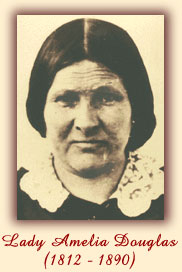The Amelia Douglas Gallery is a non-profit organization run by members of the Arts Exhibition Committee at Douglas College. The gallery is named after the Cree wife of James Douglas, Governor of both the Colony of British Columbia and the Colony of Vancouver Island in 1858.
As modest as a wood violet ...

A traditional Victorian portrait seems to mask as much as it unveils: the grey eyes of Lady Amelia Douglas, admired by her husband, James, are muted here into the sepia ambiguities of an old photograph, yet there is something about the determined set of the jaw that might support Sir James' observation that Amelia believed "nothing could go on prosperously without her close attendance."
Amelia was born in 1812 to a Cree mother, Suzanne, and an Irish-Canadian father, William Connolly. She married James Douglas, a young fur-trader, in 1828 at Fort St. James in a traditional Indigenous ceremony when she was sixteen years old. The marriage was later formalized in accordance with the Church of England at Fort Vancouver in 1837.
Although Amelia was said to be "as modest as a wood violet," an episode early in her marriage reveals her in a considerably more dramatic light. She emerged one night from her sleeping quarters to see her husband held at knifepoint. She slipped upstairs and "commenced to throw down trade goods" in an act of spontaneous and effective diplomacy.
Amelia's Cree ancestry endowed her with a rich store of native legends which she told to her children "with the winter gloaming and the bright fire as the only light." As Sir James' political star rose, making him ultimately the governor of Vancouver Island and of the crown colony of British Columbia, Amelia held rule over her own burgeoning domestic empire. The experiences of being a mother was also a profound study in loss and perseverance. Amelia gave birth to thirteen children: of these, five daughters, Cecilia, Jane, Agnes, Alice and Martha and one son, James, survived into adulthood. When her daughter Cecilia, wife of John Sebastian Helmcken, passed away, leaving three young children, it was Amelia who stepped in to attend them. Amelia's animated storytelling wove the Douglas generations together. After Sir James died in 1877, Amelia lived on, actively involved in the life of her family and the James Bay community until her death in 1890.
Throughout her life, Amelia was known to be of great comfort to people in need. She offered support and nursing care to the sick and was known for her skilled and compassionate assistance to women experiencing complications after childbirth.
May the spirited inclusiveness, inspired storytelling and gentle determination of Amelia Connolly Douglas be remembered here. To the woman who was once, in 1864, an honoured guest at a testimonial banquet in New Westminster, we dedicate the Amelia Douglas Gallery.